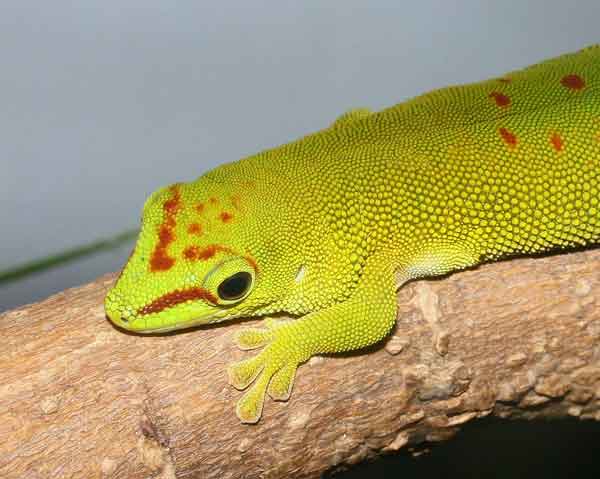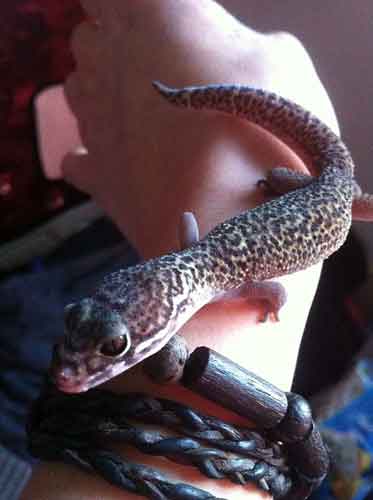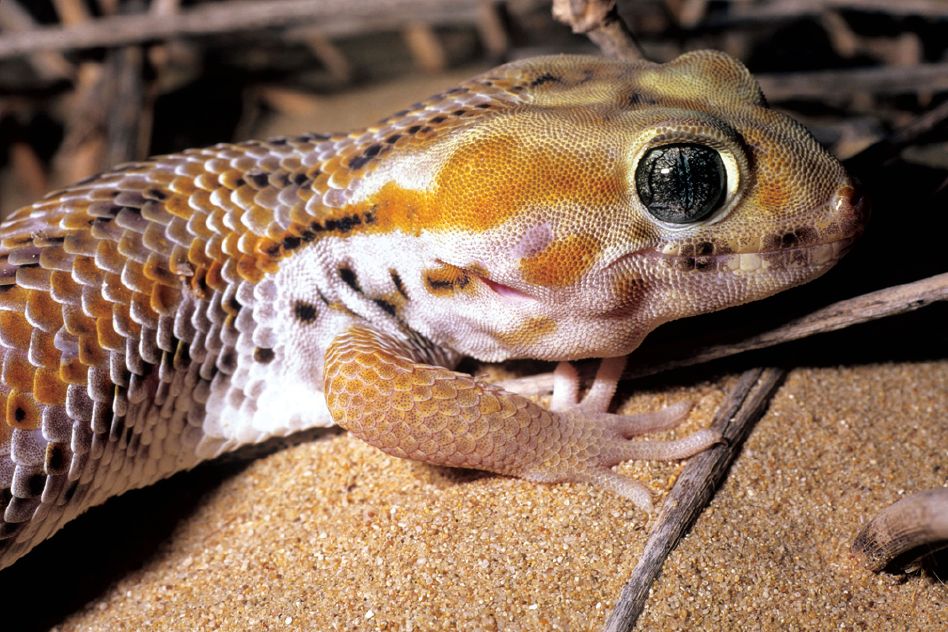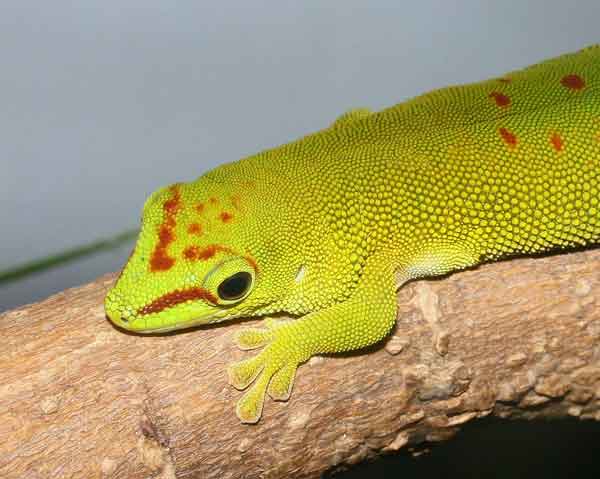Geckos are excellent pets that are relatively easy to keep.
So you've decided to get a gecko! Good choice! Geckos are excellent pets that are relatively easy to keep compared to a cat or dog. You can keep geckos in a small space in your home, they don't have any fur or feathers to make you sneeze, and they don't need to be walked!
In this article I will discuss five particular geckos that make great choices for beginners, as well as more experienced reptile enthusiasts. The giant day gecko (Phelsuma madagascariensis grandis) is a large, fluorescent-green gecko with brilliant red markings that requires a tropical terrarium. This species climbs trees with ease. The white-lined gecko (Gekko vittatus) is another large, agile tree dweller that also lives in a tropical terrarium. The ground-dwelling Madagascar ocelot gecko (Paroedura pictus) and Central American banded gecko (Coleonyx mitratus) have interesting banding patterns and are simple to keep in captivity. Roborowski's gecko (Teratoscincus roborowski), commonly known as a frog-eyed gecko, is an active burrowing gecko with scales capable of the unique ability to make a rattling sound.
Among this diverse assortment, there should be a gecko species just right for you.
Gecko Behavior and Terrarium Design
Geckos have many interesting behaviors. Most geckos are known to vocalize with a voice, an ability that is often used for territorial, self-defense and courtship behaviors (Henkel and Schmidt, 1995). Some arboreal types such as the giant day and white-lined gecko have the ability to climb glass. The Madagascar ocelot, Central American banded and frog-eyed geckos are digging and burrowing specialists.
These behaviors are easy to see if you have spent time creating a nice place for the gecko to live. You can accomplish this by reading books and care sheets as a guide to creating a terrarium based on the gecko's natural environment. Some future gecko keepers envision a beautiful tropical terrarium full of geckos; others would like their geckos to live in a miniature desert scene in their home. There are appropriate species for either type of terrarium. Matching a gecko species with the correct terrarium design and furnishings is a worthwhile endeavor. You will realize this when you see your geckos stalking crickets or basking in the surroundings you created for them.
Pet Shop Basics
There are several things to remember when shopping for the gecko of your dreams. First, are the geckos healthy? Ask if the geckos are captive bred. Captive-bred geckos should be your first choice because they are less likely to have health problems than wild caught geckos. Are healthy geckos being kept in the same cage with sick geckos or other sick reptiles? If so, look elsewhere-the healthy appearing ones may be sick, too. You do not want to start out your gecko-keeping experience with a sick gecko; this usually is much more expensive in time, energy and vet bills than most people realize.
Healthy geckos are alert and responsive to stimulation. For example, the gecko should respond to handling by alertly looking at you and moving with vigor. A healthy gecko also has good body condition and weight. Unhealthy signs include skinny body, hips protruding, sunken eyes, skin wrinkles (from dehydration), incomplete skin shed, skin tears, jaws warped or kinked tail (possible metabolic bone disease), unresponsive. Don't rule out that stumpy tailed gecko! A tailless gecko can still be a good candidate for a pet because most geckos regenerate new tails or live happily without their tails.
Once you select a healthy gecko candidate, ask the pet store employee, "What is the proper scientific name?" This is necessary to identify the gecko. Once you have identified the gecko, you can get the proper care information. Common names like "banana gecko" will be hard to look up in books or on the Internet because many geckos share the same common names. For example, a recent survey of the Global Gecko Association, when asked how many common names participants knew for the Madagascar ocelot gecko, resulted in the following names: Madagascar ground gecko, panther gecko, big-headed gecko and puma gecko. Common names lead to confusion, but scientific names are exact, helping you research and care for your gecko!
A care sheet or book should be available to buy with the gecko so you know how to house and feed it properly when you get home. Ideally, you should buy the book first, read it, set up your terrarium, then buy the gecko. The care information should briefly cover the gecko's natural environment, how to set up a terrarium, what to feed the gecko and how often to feed it.
Feeding Tips
The basic diet of most geckos is crickets (Acheta) and or mealworms (Tenebrio). A good basic rule for feeding geckos is to offer them food items that are about 90 percent the size of their heads. Smaller food items often are ignored, and larger food items, although very exciting to your gecko, will be too big for them to eat. Geckos, like you, appreciate variety in their diet. Try commercially available foods such as wax worms (Galleria) and super worms (Zoophobas).
Offer wax worms only occasionally, because they are high in fat and your gecko may refuse more nutritional food if fed wax worms on a regular basis. Most tropical geckos enjoy fruit puree or baby food and fruit flies. Top off your gecko's meal with a dusting of a quality multivitamin supplement with calcium, phosphorus and D3. Leave a shallow dish of calcium in the terrarium with breeding females; this is necessary to replenish calcium reserves used up from egg production.
Giant Day Gecko
Giant day geckos have all the qualities of an excellent terrarium display gecko: diurnal (day active) behavior, acrobatic glass climbing abilities and bright green and red coloration. The giant day gecko may grow up to 12 inches and live up to 30 years in captivity (McKeown, pers. comm.), further increasing its appeal as a terrarium pet. This hardy tropical gecko from Madagascar is best kept individually or in a pair of one male and one female (McKeown, 1993). Sex may be accurately determined after the age of 4 months. Males have enlarged femoral pores located on their undersides just before their vents, and hemipenile bulges after the vent. Females have smaller femoral pores than males, and the hemipenile bulges are absent.

Greg Hume/Wikipedia
The giant day gecko will lick the sprayed water droplets from the leaves and sides of the terrarium surfaces. Feed these geckos 3- to 4-week-old crickets as a regular diet.
A tropical terrarium with plants and full-spectrum lighting is ideal for giant day geckos. A 20- gallon tall terrarium or larger is adequate for a pair of adults, vertical space being more important than horizontal space for these arboreal geckos (McKeown, 1993). Terrarium furniture should consist of at least 2-inch bamboo, similar shaped PVC pipe or wood placed diagonally and/or horizontally, so the lizards can rest comfortably under a basking lamp that reaches about 86 degrees Fahrenheit during the day. A nighttime temperature drop is good, although nighttime temperatures should be no lower than the high 60s (Fahrenheit) range. There should be plants in the terrarium such as pothos (Epipremnum aureum) that the geckos can hide behind. You may also use sturdy plants strong enough to support the weight of the geckos, such as snake plant (Sansevieria). It is good to provide day geckos with a variety of resting places. Use 2 to 3 inches of potting soil or sphagnum peat moss covered with medium grade orchid bark as the ground surface, and sit your plants in pots on top of this substrate. To increase beneficial humidity for your giant day geckos, plant your plants directly in the substrate.
To provide water to day geckos, spray the sides of the terrarium and plants once or twice daily depending on your home's humidity; if it is on the dry side (below 50 percent), spray more often. To measure humidity you need an instrument called a hygrometer, which often is available at home electronics stores in a convenient combination with a temperature gauge. The giant day gecko will lick the sprayed water droplets from the leaves and sides of the terrarium surfaces. Feed these geckos 3- to 4-week-old crickets as a regular diet. Mealworms, wax worms, super worms, large fruit flies and fruit baby food or puree are great as occasional snack foods. If well fed, they reach sexual maturity in seven to nine months. They are very easy to breed and may lay as many as 36 eggs a year!
Should it be necessary to move your giant day gecko when cleaning its terrarium or for medical care, handle it indirectly with bird nets. If you grab them, their skin may tear off and they may lose their tails. Their skin and tail will grow back, but will not be as beautiful. Think of day geckos as you do tropical fish–they are best observed and admired, not held.
White-Lined Gecko
The white-lined gecko (Gekko vittatus) is a mild-mannered relative of the popular tokay gecko (Gekko gecko) with few of the tokay's aggressive tendencies. This large, slender green or brown gecko with a white stripe running down its back is also sometimes called the skunk gecko because of its appearance. Native to the tropical Indo-Australian Archipelago, this agile gecko climbs about trees and human dwellings with large toes designed for maximum grip (Henkel and Schmidt, 1995). This attractive gekkonid sometimes exhibits an interesting behavior by curling its tail when disturbed.
The white-lined gecko, which reaches a total length of about 10 inches, may live in the same type of tropical terrarium set-up as the giant day gecko (Henkel and Schmidt, 1995). A pair can live in a tall 20-gallon or larger terrarium, a trio may be kept together in 35-gallon or larger terrarium. Humidity should be about 75 percent and temperatures should be in the mid-80s Fahrenheit range during the day (Henkel and Schmidt, 1995). Sex determination and feeding is the same as with the giant day gecko, crickets as the regular diet. Breeding of this gecko requires little effort, and beginning keepers with no previous experience often are successful.
Central American Banded Gecko
The Central American banded gecko (Coleonyx mitratus) is a tropical forest floor dweller that ranges from Guatemala southward to Costa Rica (Grismer, 1997). This slender, attractively patterned, nocturnal gecko reaches a total length of about 6 to 7 inches (Tytle and Stevens, 1993). Breeders have found the Central American banded gecko hardy and easy to keep (Hiduke and Gaines, 1997). These geckos tolerate handling in small doses.

Henryhyrden/Wikipedia
This slender, attractively patterned, nocturnal gecko reaches a total length of about 6 to 7 inches.
A traditional glass terrarium or plastic shoebox set-up is suitable housing for this secretive gecko. If using a glass terrarium, a 10-gallon is more than adequate for a breeding pair of adults.
Sexually mature male geckos can easily be differentiated from females by the presence of hemipenile bulges at the age of 6 to 9 months. Central American banded geckos do not climb glass, so you don't have to worry about them escaping unless you give them a "ramp" to the top of the terrarium! Terrarium furniture should include hiding places. These hiding places offer a gecko needed security by not being visible to the outside world. A small plastic margarine tub with a gecko-sized entrance hole on top works well for this purpose. Fill the container with 3/4-inch of moist vermiculite and it will serve multiple purposes-an ideal place to hide, shed skin and lay eggs.
Succulent plants like aloe or snake plant work well in a gecko terrarium. (Plastic plants are good for those of us who can't keep plants alive!) Use 2 inches of a 70-percent sphagnum peat moss to 30-percent play sand mixture for the bottom of the terrarium (Tytle and Stevens, 1993). Breeders have also had success using cypress mulch, because this allows tunneling, a natural behavior, and provides adequate moisture (Hiduke and Gaines, 1997). Both types of substrates provide the necessary humidity the Central American banded gecko likes. The warm side of the terrarium should be 76 to 84 degrees Fahrenheit during the day. If using a shoebox, drill at least two 1/4-inch holes on each side of the box. You may use heat tapes or reflector lamps (in glass terrarium only) to provide heat. Full-spectrum lighting is not necessary. Spray the sides of the terrarium with water once daily to provide the gecko with a drink, and feed 3-week-old crickets three to four times weekly. Wax worms are appreciated as an occasional treat.
Madagascar Ocelot Gecko
Madagascar ocelot geckos (Paroedura pictus) are nocturnal terrestrial geckos from the dry regions in southern Madagascar (Henkel and Schmidt, 1995). During the day they can be found hiding under rocks, loose bark, leaf litter or burrowed in sand. They reach a total length of about 5 inches (Bartlett and Bartlett, 1995). They are also known as "big-headed geckos" because of their large heads. There are two color pattern types, striped or banded. Sex is determined at the same age and manner as the Central American banded gecko.
Like the Central American banded gecko, a breeding pair or trio (one male and two females) of Madagascar ocelot geckos are well suited to life in a plastic shoebox or 10-gallon terrarium. Since the Madagascar ocelot gecko is from a drier climate than its Central American cousin, use a drier 2-inch mix of 30 percent sphagnum peat moss to 70 percent sand. Daily temperatures should be 82 to 88 degrees Fahrenheit (Bartlett and Bartlett, 1995). Again, 3-week-old crickets should be the staple diet three to four times weekly, with mealworms and other live food items previously mentioned given as snacks. Use a water dish or spray the sides of the terrarium with water daily.
This gecko is a prolific breeder. Females lay their fragile eggs, up to 20 to 30 of them per season, directly in the sand in the bottom of the terrarium (Glaw and Vences, 1994) but these geckos will utilize a nest box if one is present. Calcium supplementation is very critical to high-frequency egg layers like the Madagascar ocelot gecko. Without adequate calcium reserves, a female quickly uses up her supply laying the large quantities of eggs, putting her life at risk.
Frog-Eyed Gecko
Frog-eyed geckos (genus Teratoscincus), are nocturnal, terrestrial burrowing geckos also known as plate-tailed and wonder geckos. Two forms are sometimes seen in pet shops, T. roborowski and T. scincus scincus. T. roborowski, also known as Roborowski's gecko, was recently imported into the United States in large numbers from Northwestern China. Prior to this, Roborowski's gecko was only seen in a few private collections in the United States. There is sparse literature written specifically for Roborowski's gecko, however, the author has had success applying captive husbandry techniques known for T. scincus scincus.

Andrew S. Gardner/Wikipedia
Teratoscincus scincus keyserlingii
Roborowski's gecko, a stout reptile measuring 4.75 to 5.5 inches, is covered with various shades of brown-orange bands that become more flecked in appearance as the gecko ages (Lui, 1994). The body is covered in fish-like scales that can easily be dislodged by handling, which necessitates indirect handling techniques. When disturbed, Roborowski's gecko, like all types of Teratoscincus, may rattle its scales. This is thought to be a self-defense, courtship and territorial behavior (Knight, 1992). Sex is determined in mature geckos by the presence of hemipenile bulges in males, obviously absent in the females. Three-week-old crickets and mealworms are eagerly eaten by the geckos during the evening hours when they are active.
Roborowski's gecko comes from Turpan, a very hot desert along the ancient "silk road" in northwestern China (Lui, 1994). This area is also known as "Huozho," meaning "land of fire," where temperatures are extreme. Summers are as hot as 104 degrees Fahrenheit, winters as cold as 5 degrees Fahrenheit. Roborowski's gecko lives in deep, moist burrows in the desert, therefore, a terrarium with deep sand and lots of heat is appropriate. Use at least a 15- to 20-gallon glass terrarium of sturdy construction for a pair of these active geckos. Be sure to put the terrarium in its permanent location before putting the sand in because it will get heavy! Put about 6 inches of sand in the bottom of the terrarium (Girard, 1996). Designate one end to be the "moist" end and spray the sand with water and mix it in. Cover an 8 1/2- by 6- by 3-inch commercial plastic hide box or similar PVC pipe with sand on the moist end to provide an entrance to the "burrow." Insert a smaller diameter PVC pipe vertically into the moist side and put water in it daily to keep the moisture level up in the burrow. Spray one side of the terrarium in the evenings to provide a drink of water.
The next step in setting up your Roborowski's gecko terrarium is to set up a reflector lamp with an incandescent bulb that will provide a surface temperature of 95 to 100 degrees Fahrenheit daily. Nighttime temperatures should be from 68 to 72 degrees Fahrenheit. In the winter, Roborowski's gecko is accustomed to hibernation, so gradually lower winter temperatures to 50 to 60 degrees Fahrenheit for a three-month period, then gradually warm the geckos in the spring. A temperature drop in the winter is necessary if you wish your geckos to breed in the spring.
Your Gecko's First Day Home
Once you have selected your gecko, the first day home should be a quiet one. Often it will take a few days for the gecko to adapt to its new home. Offer food on the second day. If the first few crickets or mealworms are not eaten within a one-hour period, remove them and try again the next day. Avoid leaving too many crickets in with your new gecko because this causes stress to the gecko, and the crickets soon lose their nutritional value since there is nothing for them to eat in the terrarium.
Quarantine and Veterinary Care
If you are planning to introduce your new gecko to a terrarium with geckos already in it, be sure to first quarantine your new gecko away from the established lizards for two to three months until you are sure it is healthy. You do not want to infect your geckos by introducing a new specimen you are not sure is ill, even if it looks healthy. A fecal exam by a veterinarian familiar with reptiles is a good way to verify a gecko's health. It is wise to have the name and number of a veterinarian handy so you will not have to scramble finding one in case of an emergency.
Conclusion
These five great pet shop geckos are outstanding choices for pets and should provide you with many years of enjoyment. There are, however, many more great gecko choices, because this is an incredibly large and diverse group of reptiles. There is a gecko to please everyone!
The author would like to thank Christine Harney, Sean McKeown, Philip A. Tremper, Jr. and the Global Gecko Association for inspiration and valuable assistance.
References
Bartlett, R.D. and Patricia P. Bartlett. 1995. The ocelot gecko. pp.84-85 in Geckos: A Complete Pet Owner's Manual. Barron's Educational Series, Inc. Hong Kong.
Girard, Francis. 1996. Captive Husbandry and Reproduction of Teratoscincus scincus. Dactylus 3(1): 4-6.
Glaw, Frank and Miguel Vences. 1994. A Field Guide to the Amphibians and Reptiles of Madagascar. Moos Druck, Leverkusen and FARBO. Germany. Grismer, L. Lee. 1997. Eublepharid Geckos: living relics of evolution. Fauna 1(1): 26-33.
Henkel, Wilhelm Friederich and Wolfgang Schmidt. 1995. Geckoes: Biology, Husbandry and Reproduction. Krieger Publishing Company. Malabar, Florida. Hiduke, Joe and Meadow Gaines. 1997. Central American Banded Geckos: Coleonyx mitratus. Reptiles 5(10): 76-87.
Knight, C. Michael. 1992. Tail Stridulation Behavior in Teratoscincus scincus. Dactylus 3(1): 4-6.
Lui, Wai. 1994. In Search of Roborowski's Gecko, Teratoscincus roborowski. Dactylus 2(3): 93-97.
McKeown, Sean. 1993. The General Care and Maintenance of Day Geckos. Advanced Vivarium Systems. Lakeside, California.
Tytle, Tim and Paul Stevens. 1993. Maintenance and Breeding of the Central American Banded Gecko. Vivarium 5(2): 18-19.


